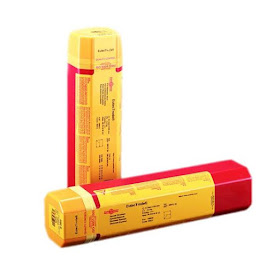4. Hard Facing welding electrode
Application-
Hard facing overlay on: Tractor Rollers; Idlers
and Drive Sprockets; Power Shovel Tumblers;
Shafts; Trunnions; Cams; Mine Car and Crane
Wheels. Brake Drums; Pinch Rolls; Coiler
Rolls; Continuous Caster Rolls; Extruder Rams;
Shafts; Rail ends (Wear shield MM40).
Benefits of Hard facing
Hard facing is a low cost method of depositing wear
resistant surfaces on metal components to extend service
life. Although used primarily to restore worn parts to
usable condition, hard facing is also applied to new
components before being placed into service.
In addition to extending the life of new and worn components, hard facing provide
Fewer replacement parts needed. Operating efficiency is increased by reducing
downtime.
Less expensive base metal can be used. Overall costs are reduced.
Build-up and Hard facing
Restoring worn parts frequently involves the following
three steps:
1.Buttering — For a deposit that will dilute the carbon
and alloy content of base metal.
2.Build-up — Seriously worn areas should be rebuilt
close to working size using tough, crack-resistant
welding materials which can be deposited in an
unlimited number of layers
3.Hardfacing — Wear resistant surfaces deposited on
the base metal or on build-up deposits extend service
life. Hard facing is usually limited to one, two, or three
layers.
Consumable Selection
Welding material selection depends upon three major
factors:
1. Base Metal — Primarily affects the choice of
build-up materials.
a. Manganese steel is used for components subject
to high impact loading. Rebuild to size using manganese steel weld deposits.
b. Carbon and alloy steel components are rebuilt to
size using low alloy steel weld deposits.
2. Type of Wear — The primary consideration in selecting the final hard facing layers is the type of wear to be
encountered in service. These include:
a. Metal-to-Metal Friction —
Wear from steel parts
rolling or sliding against each other with little or
no lubrication.
b. Severe Impact —
Wear from severe pounding
which tends to squash, gouge and crack the
surface. Manganese steel deposits, which work
harden in service, provide the greatest impact
wear resistance.
c. Abrasion Plus Impact — Wear from gritty material
accompanied by heavy pounding which tends to
chip or crack, as well as grind, away the surface.
d. Severe Abrasion — Wear from gritty materials
which grind or erode the surface. Severe abrasion
is often accompanied by heavy compression or
moderate impact. Hard deposits are required to
resist abrasion but they may also need substantial
impact resistance.
e. Metal-to-Earth Abrasion — Wear from earth-like
materials accompanied by moderate impact
(pounding.)
f. Corrosion — Chemical attack.
In many, if not most cases, the effective wear is a
result of a combination of two or more of the
phenomena described in this section.
TYPICAL CHEMICAL COMPOSITION OF ALL WELD METAL DEPOSITS
C Cr Fe
3.5 35.0 Balance






Comments